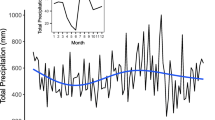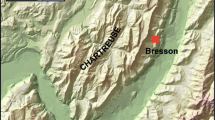Abstract
Six hundred and eleven Great Basin bristlecone pines (Pinus longaeva) were surveyed in two separate groves in California’s White Mountains. The presence and direction of spiral grain were recorded for each tree as well as elevation above sea level, horizon angles, latitude and longitude, trunk diameter, whether the tree was dead, and whether the trunk was broken. The proportions of left-handed, right-handed and straight trees were similar in every part of both groves, although the groves lie at different elevations. No significant correlation was found between the direction of spiral grain and any environmental factor. The hypothesis that spiral grain is an adaptation to distribute sap evenly between the roots and the crown in Pinus longaeva is not strongly supported, since spiral grain is not correlated with asymmetric environments and most trees exhibit <90° rotation through the main stem. The data also do not support the idea that spiral grain makes the tree more resistant to breaking in strong winds. Right-handed spiral grain is predicted by this hypothesis, but most bristlecone pines are either left-handed or exhibit no spiral grain. Bristlecone pines are often uprooted from thin soils by strong winds, but rarely are the main stems broken by this mechanism. Spiral grain in Pinus longaeva growing in California’s White Mountains does not appear to be under environmental control.


Similar content being viewed by others
References
Anstett D (2010) The influence of wind and light exposure on the extent of lichen coverage in an alpine environment. Univ Tor J Undergrad Life Sci 4:38–41
Danborg F (1994) Spiral grain in plantation trees of Picea abies. Can J For Res 24:1662–1671
Eklund L, Säll H (2000) The influence of wind on spiral grain formation in conifer trees. Trees 14:324–328
Gjerdrum P, Bernabei M (2009) Three-dimensional spiral grain pattern in five large Norway spruce stems. Silva Fennica 43:457–464
Hansen JK, Roulund H (1997) Genetic parameters for spiral grain, stem form, pilodyn and growth in 13 years old clones of Sitka spruce (Picea sitchensis (Bong.) Carr.). Silvae Genetica 46:107–113
Harris JM (1989) Spiral grain and wave phenomena in wood formation. Springer, Berlin, Heidelberg, New York
Hegstrom RA, Kondepudi DK (1990) The handedness of the universe. Sci Am 262:108–115
Kubler H (1991) Function of spiral grain in trees. Trees 5:125–135
Lanner RM (2007) The bristlecone book. Mountain Press, Missoula
Leelavanichkul S, Cherkaev A (2004) Why grain in tree’s trunks spirals: mechanical perspective. Struct Multidiscip Optim 28:127–135
Muir J (1894) The mountains of California. Century, New York, pp 216–219
Paul BH (1956) Changes in spiral grain direction in Ponderosa pine. USDA Forest Products Laboratory Report No. 2058, Madison
Säll H (2002) Spiral grain in Norway spruce. Doctoral Thesis, Växjö University Press, Växjö
Schulgasser K, Witztum A (2007) The mechanism of spiral grain formation in trees. Wood Sci Technol 41:133–156
Skatter S, Kucera B (1997) Spiral grain—an adaptation of trees to withstand stem breakage caused by wind-induced torsion. Holz Roh Werkst 55:207–213
Skatter S, Kucera B (1998) The cause of the prevalent directions of the spiral grain patterns in conifers. Trees 12:265–273
Wloch W, Mazur E, Beltowski M (2002) Formation of spiral grain in the wood of Pinus sylvestris L. Trees 16:306–312
Zobel B, Stonecypher RW, Browne C (1968) Inheritance of spiral grain in young Loblolly pine. Forest Sci 14:376–379
Acknowledgments
The authors thank the staff of the University of California’s White Mountain Research Center for hosting our stays in the field. This project was made possible by financial support from the Drake Fund. We thank the many volunteers who participated in this project, including Olivia Ashmoore, Mary Buchanan, Cooper Clark, Dorcy Brownback Curth, Sandy Curth, Jordan Doering, Brennan Duff, Greg Gabel, Matthew Gabel, Murphy Goodwin, John Hayden, Cole Hersey, Daniel Hunt, Sophia Lahey, George Lightfoot, Lori Martz, Rich Melbostad, Emma Mooney, Anthony Scopazzi, Jonathan Scopazzi, Jonathan Sicroff, Olivia Sicroff, Jack Sims, Abby Smith, and Cesi Solari. We thank Michelle Lackney for guidance on the use of statistics.
Author information
Authors and Affiliations
Corresponding author
Additional information
Communicated by L. Gratani.
Electronic supplementary material
Below is the link to the electronic supplementary material.
Rights and permissions
About this article
Cite this article
Wing, M.R., Knowles, A.J., Melbostad, S.R. et al. Spiral grain in bristlecone pines (Pinus longaeva) exhibits no correlation with environmental factors. Trees 28, 487–491 (2014). https://doi.org/10.1007/s00468-013-0965-y
Received:
Revised:
Accepted:
Published:
Issue Date:
DOI: https://doi.org/10.1007/s00468-013-0965-y




